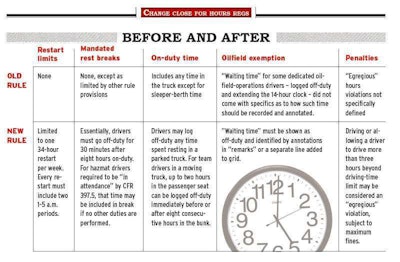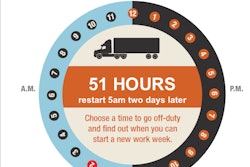
 Some observers predict new restrictions on the 34-hour restart requiring each restart to include two 1-5 a.m. periods could have unintended effects on early-morning highway and parking congestion.
Some observers predict new restrictions on the 34-hour restart requiring each restart to include two 1-5 a.m. periods could have unintended effects on early-morning highway and parking congestion.The hours of service revisions the Federal Motor Carrier Safety Administration made final in late 2011 went into true effect Monday, July 1, affecting how drivers handle rests and restarts. The July 1 compliance date for new rules remained effective in the wake of a hearing about industry impacts conducted in the U.S. House of Representatives June 18 and which saw calls for FMCSA to delay implementation.
Following the hearing, a petition launched by Minnesota-based independent owner-operator Jason Haggard remains circulating calling on Congress to force FMCSA Administrator Anne Ferro to delay implementation of the hours changes, pending results of a MAP-21 highway-bill directed real-world effectiveness study under way. As of June 29, with two days remaining, the petition had almost 500 signatures and continued to grow.
Technically, the rule’s “effective date” was more than a year ago, notes FMCSA spokesman Duane Debruyne. “Carriers that have not been adhering to the Final Rule since Feb. 27, 2012, have been noncompliant,” he said. (For a quick-glance summary of the changes, see our chart at the bottom of this story and via this link.)
Also giving credence to a delay in enforcement, the federal appeals court in Washington, D.C., has yet to decide in a case brought by the American Trucking Associations and joined by the Owner-Operator Independent Drivers Association that challenges new restrictions.

Some fleets already use the two hours of passenger-seat off-duty time for team drivers before or after at least eight hours in the sleeper berth, says Eric Witty, Qualcomm OmniTracs product manager. Witty knows because his customers have been helping the company update its electronic logging system to help carriers and drivers self-enforce and monitor the provision appropriately.
As with previous hours rewrites, more restrictive provisions are not being followed in large part yet, though some owner-operators have tried them out. Some – such as Waco, Texas-based independent Cody Blankenship – will see little change. His reefer-hauling round has him out on a typical four-to-five-day turn, then back home every weekend with plenty of time for a restart, including the two 1-5 a.m. rest periods required by the new rule.
“FMCSA might just be handing us a freight rate increase.” —owner-operator Jeff Clark at his blog, about what he sees as a need for a shift in view on regulated miles/hours-supply reductions throughout the industry
However, Blankenship worries about how the restart “is going to work with my ag trailer.” In certain seasons, he runs a hopper bottom hauling from farm fields. “There’s a lot of sitting around there” on-duty, he says. In such situations, drivers maxing out 70 on-duty hours in as few as five days could be stuck waiting there for more hours, given the new limitation of a single restart a week – measured from the beginning of the last one.
Missouri-based long-haul company driver Todd McCann, employed by a large dry van fleet he declines to name, blogs and podcasts routinely via his AboutTruckDriving.com site. Analyzing four of his restarts this spring, he concluded that only one would have been legal after July 1.
 Time spent waiting in a parked truck and logged off-duty could include, FMCSA says, extended periods spent waiting at shipper/receiver facilities.
Time spent waiting in a parked truck and logged off-duty could include, FMCSA says, extended periods spent waiting at shipper/receiver facilities.However, in the other three, McCann would have had no problems making his appointments without the restart. Generally, he says, “As long as I can keep running, I’ll keep running – I don’t want a 34-hour if I don’t have to take one. The only time I stop [for the restart] is if I might as well.”
For McCann, the problem of not having the option of the 34-hour restart in those instances is simply a matter of reduced flexibility down the line. “There would have been no benefit sitting for 34 hours straight,” he says.
If he’s grateful for anything in the new rules, it’s that FMCSA didn’t get rid of the option of splitting 10-hour sleeper-berth periods into one eight-hour and one two-hour period. But FMCSA has changed on-duty definitions in other ways that could prevent drivers and owner-operators tied up at shippers and receivers – or, as in Blankenship’s example, delayed by weather in ag operations – from maximizing their on-duty hours.
Drivers now will be able to legally log time spent resting in a parked vehicle as off-duty, so some of that detention time might not eat up on-duty hours; previously, only bunk time in the truck qualified as off-duty. These changes could make running solely on the recap – within the constantly revolving duty limits of 70 hours in eight days, or 60 in seven days for drivers with carriers who shut down totally at least one day of the week – a potentially more palatable proposition, without sacrificing a lot of drive time.
Some drivers have expressed worry over whether carriers would use the on-duty definition change as a reason to cut into driver detention pay – for those fortunate enough to receive it. In general, though, drivers throughout a variety of operations are taking a wait-and-see approach as to how the new rule ultimately affects their incomes.
It was possible, McCann points out, that with the current restart practices, a driver’s workweek could amount to up to 82 hours in a seven-day period if everything lined up just right; the new limitations will reduce that to a maximum 70. The calculation includes not only restart limitations but also the newly mandated 30-minute off-duty break after eight consecutive driving hours without an off-duty period of at least that length.
Wisconsin-based owner-operator Jeff Clark said he was hopeful a systemwide reduction in available hours would boost driver/carrier demand while also boosting rates. Clark, sharing comments he posted May 30 on his Freightliner Team Run Smart blog, urged an industry that often seems hell-bent on fighting any new revisions that limit hours to revise its way of thinking.
“While it is our natural inclination as an industry to maximize productivity, we may be lowering our rates by doing that,” he wrote. “Through the next rounds of [hours of service] changes, the government is reducing the supply of available driver miles. Instead of fighting against them, maybe we should sit back and think two or three steps ahead. FMCSA might just be handing us a freight rate increase.”
Click through the chart for a larger version.














